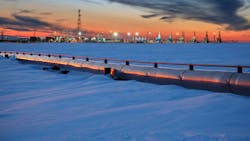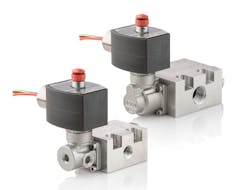Solenoid Valve Quality in Arctic Can Impact Oil and Gas Applications
Low ambient temperatures are prevalent in many oil and gas, hydrocarbon, refining and power applications. But these conditions can compromise the reliability of your mission-critical solenoid valves, which must be able to withstand extremely cold conditions—often unattended. Even low-temperature storage and processing lines can affect a valve’s material flexibility and seal integrity over time.
To overcome these challenges, many fluid automation manufacturers offer specially designed products that can handle temperatures down to −60° C. These components also offer the right combination of low-power capabilities and certifications, guaranteeing they perform as expected—even in Arctic regions like Alaska and Canada, as well as the North Sea and Siberia.
Choosing solenoid valves for extremely cold, remote environments require a look at the technologies that address the issues associated with low-temperature environments. This can guarantee the long-term success of oil and gas operations.
Low Temperatures Affect Valve Performance
Remote, low-temperature environments can degrade the performance of solenoid valves in several ways:
Cold temperatures compromise seal integrity. Falling temperatures have a negative effect on the elastomers in the valve disc or diaphragm. These materials depend on their elasticity to provide an effective seal for the valve seat. As they get colder, elastomeric polymers shrink. They also become hard, brittle and glass-like when they eventually hit their glass transition temperature. Together, these changes prevent the disc from properly conforming against the seat—opening up the possibility of leak paths.
Infrequent actuation can cause valve dormancy. In addition to compromised material flexibility, valves in harsh, frigid environments run the risk of dormancy, which occurs when the valve is operated at infrequent intervals or in low-cycling applications. When the valve’s O-ring seal stays in uninterrupted contact with the body or main spool of the valve for extended periods of time, the seal can adhere against grooves and other imperfections in the metal surface of its mating components. As a result, the valve—when finally actuated—responds slowly or not at all.
Remote locations affect your power demands. A third important consideration for low-temperature valves is power consumption. Components that consume minimal power will lower your energy costs in remote locations, such as oil and gas transmission pipelines or extraction sites. Conventional valves in these kinds of applications may require heat tracing or protection—necessitating larger, more costly power supplies like battery charging systems or solar panels.
Because low temperatures threaten valve reliability, it’s important to select high-quality components that avoid the challenges associated with extremely cold, remote environments. One way to do this is by evaluating each vendor’s reputation and record of reliability.
One example of a technology that meets these requirements is the ASCO Series 381 valve, which provides reliable operation in extremely harsh, cold and corrosive environments, including those found on offshore and near-shore oil platforms.
Rated for air, inert gas and sweet dry natural gas, this rugged, 316L stainless-steel device features industry-proven low-power solenoid technology—making it a reliable choice for remote locations where minimal power consumption is necessary.
In particular, when assessing their solenoid valve offering, look for components that carry applicable approvals from global agencies, standards organizations and equipment directives. Examples include Underwriters Laboratories (UL), Canadian Standards Association (CSA) and Explosive Atmospheres (ATEX). Selected constructions may also produce third-party certifications, such as Canadian Registration Number (CRN) and Safety Integrity Level (SIL) ratings. ASCO solenoids also carry UL, CSA, ATEX and IECEx approvals—allowing them to be used in arctic areas around the world.
Bob Cadwell is business development manager at Emerson.

